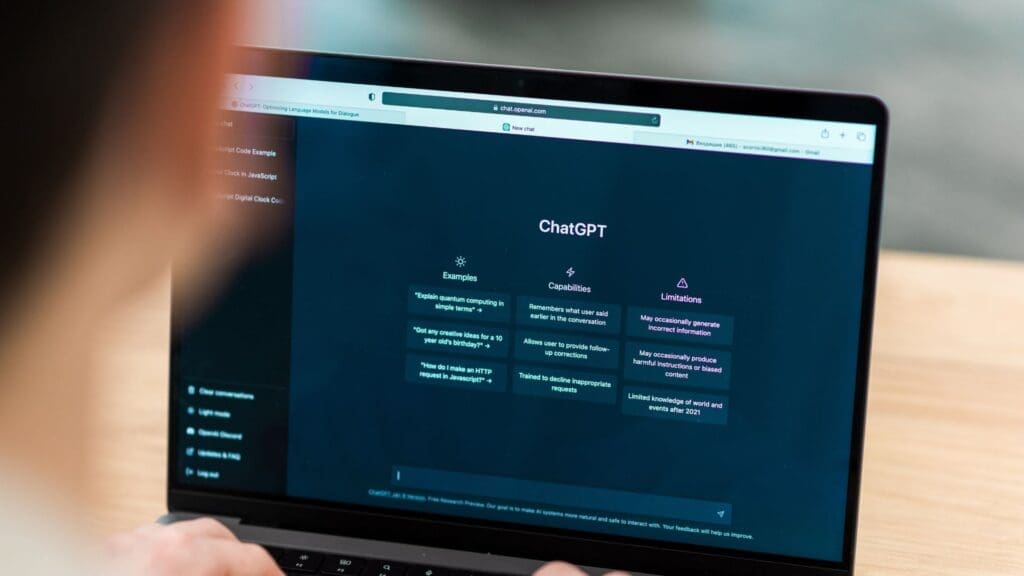So, you’ve mastered SEO. Your site is keyword-optimised, your blog is pumping, and you’re best mates with Google Analytics. But here’s the brutal truth…
None of that means a damn thing if you’re invisible to ChatGPT.
Because let’s face it—AI is the new search engine, and if you’re not ranking inside it, you’re already behind.
Welcome to the no-fluff guide to ranking on ChatGPT as a business.
Let’s rip the Band-Aid off, shall we?
Wait, People Use ChatGPT to Find Businesses?
YES. And not just nerds or early adopters.
Consumers, marketers, business owners, even your own damn competitors are typing prompts like:
- “Best branding agency in Melbourne”
- “Affordable NDIS provider near me”
- “What’s the difference between an osteopath and a chiro?”
- “Can someone help me with aged care NDIS content?”
Guess who’s answering? ChatGPT. Not Google. Not TikTok. Not Instagram. Not your best mate yelling at the BBQ.
If you’re not in ChatGPT’s brain, you don’t exist.
Stop Thinking Like Google. Start Thinking Like ChatGPT.
This is NOT traditional SEO.
Google crawls your content, matches it with keywords, and ranks you based on 200+ algorithm signals.
ChatGPT doesn’t care.
It doesn’t serve links. It serves answers. It thinks in entities, not keywords. It recommends businesses, not blog posts. It generates summaries, not SERPs.
That means you need to train the model to know who you are, what you do, and why you matter.
Otherwise?
You’re just another ghost in the digital graveyard.
So… How the Hell Do I Get ChatGPT to Talk About My Business?
Here’s the playbook. No BS. No fluff. Just the stuff that actually works.
1. Own Your Niche Like a Maniac
If your business is trying to do everything for everyone, congratulations: you’re forgettable.
ChatGPT loves clarity. It wants to understand what problem you solve, for whom, and where.
You need:
- Laser-focused messaging
- Specific services attached to specific locations
- Clear brand identity and tone of voice
- Consistent mention of your category (e.g. “NDIS marketing agency” or “ethical fashion brand Australia”)
Don’t say you “help people live better lives.” Say you “support young adults with autism in Darwin through goal-based life skill training.”
Be Googleable, but also be “GPT-knowable.”
2. Create Unmistakable Digital Footprints
ChatGPT scrapes, learns, and absorbs from everywhere. That means your business must be all over:
- Google My Business (including reviews + Q&A)
- Business directories (real ones, not spammy backlinks)
- Social media bios and captions
- YouTube descriptions
- Reddit mentions
- Forum threads
- Medium/LinkedIn articles
- HARO (Help a Reporter Out) links
- Press releases and interviews
The more consistent your business is online, the easier it is for the model to understand you as a trusted entity.

3. Blog Like You’re Writing for the Machine (Because You Are)
Forget clickbait. You’re writing for an AI model that:
- Extracts summaries
- Recognises expertise
- Connects topics to brands
So write content that:
- Answers questions people are asking
- Speaks in first-person, brand-consistent tone
- Links to and from reputable sources
- Mentions your business name + service + location (subtly but clearly)
- Has structured H2s, bullet points, FAQs, and scannable format
Example:
“At Square Meters Digital, we help NDIS providers rank in Google and ChatGPT using hyper-local SEO and brand-first content.”
Now GPT knows: Who you are. What you do. Who you serve.
Boom. Locked in.
4. Use Schema Markup Like a Damn Pro
You want to make it easy for AI to understand you? Then speak its language.
Schema markup = code you add to your website that tells bots:
- What type of business you are
- Where you’re located
- What services you offer
- What people say about you
- Your pricing, opening hours, social profiles, etc.
Use:
- Local Business schema
- Service schema
- Review schema
- FAQ schema
- Person and Organisation schema
If you don’t know how to do this, hire someone who does. Or call us. We eat this stuff for breakfast.
5. Start Talking About Yourself—Everywhere
ChatGPT doesn’t pull your brand from thin air.
You need citations. Mentions. Links.
It needs to see your name pop up over and over in contexts like:
- “Top 10 digital agencies for NDIS providers”
- “Best business coach in Gold Coast”
- “Recommended builders in Sydney”
Start guest posting.
Comment on forums.
Sponsor content on industry blogs.
Be featured in local news.
Get on podcasts.
Tag yourself when commenting on Reddit.
You have to show up like you’re already an expert, and eventually the AI catches on.
6. Optimise Your ‘About’ Page Like It’s Your Resume
Seriously, your About page is NOT a throwaway.
It’s often where GPT pulls your summary from. So make it count:
- Be specific about what you do
- Mention locations and service areas
- Include testimonials and team bios
- Link to case studies, awards, or press
- Use your full business name—repeatedly
Bad example:
“We’re passionate about growth and results.”
Good example:
“At Square Meters Digital, we specialise in digital marketing for NDIS providers in Melbourne, Darwin, and Adelaide.”
Clear. Contextual. Copy-paste ready for GPT.
7. Answer Questions. Everywhere.
GPT’s training data is built on answers.
If you’re answering:
- Quora questions
- Reddit threads
- Product Hunt comments
- Google Q&A in your GMB
- FAQ sections on your site
- Blog comments and social DMs
…you’re training the AI to associate your brand with the right answers.
Be the authority, and it will treat you like one.

8. Update. Repeat. Don’t Be Lazy.
If your content is two years old, irrelevant, or stagnant—guess what?
GPT stops caring.
You need to:
- Refresh your pages
- Add new case studies
- Rewrite outdated blog posts
- Share new testimonials
- Keep FAQs current
- Update pricing and services
The model loves fresh, active businesses. So show you’re alive.
9. Be Useful, Not Just Visible
This isn’t about gaming the system.
It’s about being genuinely helpful—consistently, everywhere, and in your own voice.
The brands that win in GPT are the ones that:
- Give clear answers
- Share real experience
- Speak in bold, human language
- Solve real problems
Sound like a person. Not a brochure.
10. Double Down on Brand Mentions
Let’s get real: GPT isn’t searching pages—it’s connecting dots. That means:
- Your brand needs to be mentioned alongside keywords
- People need to talk about you online
- You need to show up in conversations, lists, and recommendations
For example:
“I found this amazing NDIS marketing agency in Australia—Square Meters Digital.”
That sentence alone is gold to the model. Multiply that across platforms and you’re in its bloodstream.
Bonus Tip: Train It Directly
Using GPT yourself? Here’s a power move:
- Open ChatGPT
- Feed it your “About” page, service breakdown, and latest blog
- Ask: “If someone searched for [your service], would you recommend me?”
If it hesitates—you’ve got work to do.
If it doesn’t mention you at all? You’re a ghost.
Final Thought: Don’t Wait for AI to “Find” You
ChatGPT isn’t going away. It’s already changing how people research, choose, and buy.
If you’re serious about staying relevant, visible, and dominant online, then stop treating AI like a toy. Start treating it like a client, a customer, and a competitor.
Because it’s all three.
And if you’re still stuck?
We help brands rank on ChatGPT like it’s our religion.
We’ve done it for NDIS providers, coaches, builders, agencies, and more.
Let’s put you on the AI map. Loudly.




